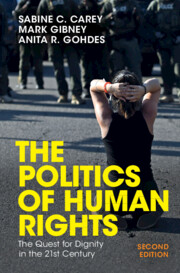Refine search
Actions for selected content:
161 results
6 - The Dangers of Chilling Effects
- from Part III - Implications
-
- Book:
- Chilling Effects
- Published online:
- 20 November 2025
- Print publication:
- 20 November 2025, pp 93-110
-
- Chapter
- Export citation
Does Ethnopolitical Exclusion Cause Civil War Onset via Grievances? Evidence from 15 Case Studies
-
- Journal:
- Perspectives on Politics , First View
- Published online by Cambridge University Press:
- 14 November 2025, pp. 1-18
-
- Article
-
- You have access
- Open access
- HTML
- Export citation
Epilogue
-
- Book:
- Waging Peace
- Published online:
- 03 November 2025
- Print publication:
- 13 November 2025, pp 408-414
-
- Chapter
- Export citation
3 - Organized Anarchy (1966)
-
- Book:
- Waging Peace
- Published online:
- 03 November 2025
- Print publication:
- 13 November 2025, pp 80-118
-
- Chapter
- Export citation

The Politics of Human Rights
- The Quest for Dignity in the 21st Century
-
- Published online:
- 12 November 2025
- Print publication:
- 06 November 2025
-
- Textbook
- Export citation
Turning a Blind Eye to Repression: Examining Popular Approval for State Crackdowns on Peaceful Protests in Russia
-
- Journal:
- British Journal of Political Science / Volume 55 / 2025
- Published online by Cambridge University Press:
- 10 November 2025, e156
-
- Article
-
- You have access
- Open access
- HTML
- Export citation
2 - What Is a Counterrevolution?
-
- Book:
- Return of Tyranny
- Published online:
- 17 September 2025
- Print publication:
- 23 October 2025, pp 18-43
-
- Chapter
- Export citation

Pious Politics
- Cultural Foundations of the Islamist Movement in Turkey
-
- Published online:
- 21 October 2025
- Print publication:
- 30 October 2025
Chapter 3 - How Advantaged Groups Create, Perpetuate, and Grow Their Advantage
- from Part I - Intergroup Relations and Group Processes
-
- Book:
- The Psychology of System Change and Resistance to Change
- Published online:
- 23 September 2025
- Print publication:
- 09 October 2025, pp 51-70
-
- Chapter
- Export citation
Chapter 2 - Revival Cheerlessness
- from Part I - Revivalism and the Call for Renewal
-
-
- Book:
- The Revival in Irish Literature and Culture
- Published online:
- 04 September 2025
- Print publication:
- 18 September 2025, pp 53-71
-
- Chapter
- Export citation
Autocrats and Their Business Allies: The Informal Politics of Defection and Co-optation
-
- Journal:
- Government and Opposition , First View
- Published online by Cambridge University Press:
- 26 August 2025, pp. 1-19
-
- Article
-
- You have access
- Open access
- HTML
- Export citation
10 - A Southern Ambiance
-
- Book:
- A Black Army
- Published online:
- 16 June 2025
- Print publication:
- 17 July 2025, pp 186-207
-
- Chapter
- Export citation
6 - A “Plantation”?
-
- Book:
- A Black Army
- Published online:
- 16 June 2025
- Print publication:
- 17 July 2025, pp 122-133
-
- Chapter
- Export citation
Chapter 13 - Migration
- from Part II - Social Contexts
-
-
- Book:
- Sean O'Casey in Context
- Published online:
- 23 June 2025
- Print publication:
- 10 July 2025, pp 140-149
-
- Chapter
- Export citation
9 - Coups and Communism in Guatemala
-
-
- Book:
- Coups d'État in Cold War Latin America, 1964–1982
- Published online:
- 24 April 2025
- Print publication:
- 08 May 2025, pp 197-214
-
- Chapter
- Export citation
Ethno-religious State Repression in Non-Democratic Regimes: A Systematic Literature Review
-
- Journal:
- Nationalities Papers / Volume 53 / Issue 3 / May 2025
- Published online by Cambridge University Press:
- 21 April 2025, pp. 499-509
-
- Article
-
- You have access
- Open access
- HTML
- Export citation
The Hong Kong-Taiwan Nexus in the Shadow of China
-
- Journal:
- Asia-Pacific Journal / Volume 20 / Issue 16 / September 2022
- Published online by Cambridge University Press:
- 14 March 2025, e7
-
- Article
-
- You have access
- Open access
- Export citation
Fixing the Past: The Effects of Human Rights Trials on Political Attitudes in Argentina
-
- Journal:
- British Journal of Political Science / Volume 55 / 2025
- Published online by Cambridge University Press:
- 14 February 2025, e26
-
- Article
-
- You have access
- Open access
- HTML
- Export citation
1 - The Imperial State
- from I - 1750–1819: The Ends of the Ancien Régime
-
- Book:
- Modern Britain, 1750 to the Present
- Published online:
- 14 January 2025
- Print publication:
- 30 January 2025, pp 3-39
-
- Chapter
- Export citation
From Collusion to Autonomy: Patterns of Hybrid Repression and Human Rights Activism
-
- Journal:
- Government and Opposition / Volume 60 / Issue 3 / July 2025
- Published online by Cambridge University Press:
- 14 January 2025, pp. 773-798
-
- Article
-
- You have access
- Open access
- HTML
- Export citation
